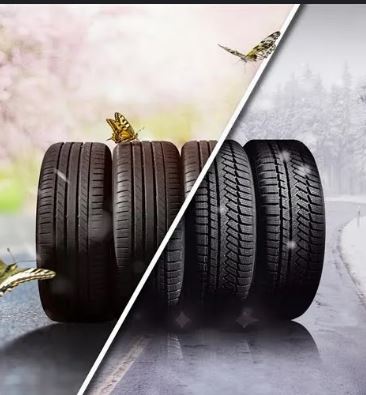1. The main functions of the tires
- I maintain the weight of the vehicle
- The shocks on irregular road surfaces resists: the pressure of the tires acts as an arch, when this pressure is in the tire at normal shares.
- Traction and braking – Using the friction force between the tire and the surface of the road, the tires help to move and bend the vehicle.
- Change and maintain the direction of the car movement – by rotating the management wheels, the direction of all wheels changes, allowing the car to move correctly.
Fixed and installed tires, fluid discs, good balances, correct pressure and, of course, leadership capacity, all of these guarantee traffic safety.

2. Suggestions from specialists to change the tires
- Choose the tires based on the car model
- Check the tires regularly, check the pressure on each supply
- Depending on the distance traveled, it periodically checks the depth of the tread and write the age of the tires, before changing the wheel set.
- When controlling the tires, apply the rule (4x4x4). This refers to the depth of the tread which must be at least 4 mm, this depth of 4 mm must exist in all 4 tires, which are not more than 4 years old.
2.1 When do winter tires change?
Specialists recommend changing tires when the average daily temperature reaches +5 ° C, +7 ° C. The average daily temperature should be understood that the arithmetic average of the quantities of temperatures of the day. In some new generation machines, when the temperature drops to +4 ° C, a warning of light is displayed on the dashboard and a sound signal. From a legal point of view, in the winter months: December, January and February, only winter tires are allowed, even if the average daily temperature is higher. However, it is not enough to capture a day with these temperatures and start the exchange, you should be sure that there is no sudden drop in temperature, snow or other extreme weather phenomena. Therefore, in addition to the arithmetic temperature calculation exercises, it is important to study long -term forecasts. If you hurry up and move to the summer tires and there is a constant on the thermometer, leave your car in the garage and use other means of transport.
We will continue to explain why the tires change according to the season and temperature.
2.2 When do the summer tires change?
Twice a year all drivers have a common question: «When the tires have changed»? There is no clear line between summer and winter, so the date of the modification of the tire should be addressed very responsible for each driver. Spring, the alternation between warm and cold days, can confuse drivers. Both in the case of summer and winter tires, their change depends on the weather conditions. You know that during the hot period, the operation with winter tires leads to their faster use. Drivers who have cars equipped with tires with cramps should not run to install the tires; You should wait for temperatures above 0 ° C at night and about +10 ° C during the day.
For impassive tires, the situation is more complicated; The dry asphalt uses the rubber very hard: a few days of driving are equal to several thousand breeds in winter.
There is also a universal option for transition periods between summer and winter and vice versa, this is the «for all seasons» tires. But in this case, you will have to allocate funds from the budget for an additional set, because «throughout the season» is also a specific rubber, it does not work properly or in winter. Tires for all seasons are a compromise between good ice and stable adhesion on dry and hot asphalt. This is impossible for the «All Season», however, being some mediocre tires.
If you keep your life, equip the summer car with summer and winter tires.
We make a small comparison between the winter and summer rubber, to understand why it is mandatory to change them.
- Winter tire: composed of a soft rubber, directional or asymmetrical tread model. The hardness for the rubbing of the tires (without screws) is 50 – 55 units and for the summer ones are 65-70 units. This is a significant difference. For this reason, the winter tires do not tan in the cold, which is why they «float» to frost temperatures, transforming them into a type of hot asphalt. The model of the tread with winter tires- a frequent groove with «Heringbone»- is acute for adhesion on snow and ice. The surface of the strip itself is covered with narrow cuts (sips). In the area of contact with the road, the threads extend, as if they were glued to the ice, which is why the winter tires thus perform on the slippery roads.
- Summer tires are designed in a completely different way. Their design aims to fight the Aquapan: the treadmill effectively removes the water from the contact patch, so that the wheel does not slide on the wet road. The hardness of the rubber task is significantly higher, to ensure stability on hot asphalt.
3. What are the risks of inadequate tires with the season
According to several studies, winter tires can be dangerous outside the season, because the soft rubber significantly affects the arrest distance and affects the maneuverability on dry and warm asphalt.
How do winter tires behave in summer?
In practice, the functioning of the winter tires, which are unnatural for this season, involves a significant increase in the braking distance. The greater the temperature, the greater the braking distance. Due to the composition of the soft tires, which reduce the rigidity and solidity of the tread, the winter tires are literally widespread on the asphalt.
At a temperature of the asphalt of +7 ° C, a car that runs with 100 km/h, equipped with winter tires, will stop 16.5 meters later than a car equipped with adequate summer tires. The winter tires, used in the summer, have shown that they are worse than 38% of the summer.
These comparisons are made very frequently abroad. Therefore, the Finns had a similar test (braking at 80 km/h) and reached the same conclusions: the car with winter tires (in summer) stopped 14 m later than normal. In addition, during the experiment, the Finns measured the speed with which Acquaplang began. At summer tires, the car maintained controllability on a track full of water, up to 84 km/h, and the car with winter tires came out of the track at 69.5 km/h.
In conclusion, it is obvious that these additional meters for the arrest distance are a real risk of entering the front car that suddenly stopped (on summer tires) or not having time to curb before the pedestrian crossing. And the first Acquaplancing is the prospect of losing control over a wet road. In this context, the increase in consumption (up to 10%) on the noise of fuel and tires seems to be a bit, but we will also mention them for reasons. In addition to intensive wear: winter tires are used 2-3 times faster than summer asphalt temperatures.
Many drivers continue to go in the summer with winter tires that are no longer good for the winter, believing that summer is still good; This is a big mistake, as you have seen in the test above, made on new, not worn tires.
4. Winter tires are mandatory in what conditions
- Under certain metrological conditions (e.g. snow or ice on the road). If you want to travel to Europe, for each country there are different rules, as we will present below.
- In exceptional cases (difficult weather conditions), it can be allowed from 1 November to 31 March for vehicles with a weight up to 3.5 tons.
- Winter tires are mandatory for cars recorded in Bulgaria and highly recommended for cars with foreign registration.
The next table represents the general conditions for tires and winter tires, for vehicles with a total weight that does not exceed 3.5 tons, from Europe:
| Tare | Winter tires | Tires with cramps | Non -Slip chains |
| Austria | obligatory
01.11 – 15.04 |
Permit
01.10 – 31.05 |
Permit
01.10 – 31.05 |
| Azerbaijan | No legal requirements | Permit | – |
| Albania | No legal requirements | Permit | Permit
01.11 – 30.04 |
| Andorra | Necessary | Permit
01.11 – 15.05 |
Permit |
| Armenia
|
obligatory
01.12 – 01.03 |
Permit | Permit |
| Bielorusia | obligatory
01.12 – 01.03 |
Permit | Permit |
| Belgium | No legal requirements | prohibited | Permit |
| Bulgaria
|
obligatory
15.11-01.03 |
prohibited | Permit
01.11 – 01.03 |
| Bosnia and Hertgrovina | obligatory
15.11 – 15.04 |
prohibited | Permit
01.11 – 15.04 |
| Great Britain | No legal requirements | Permit | Permit |
| Hungary | No legal requirements | prohibited | Permit |
| Germany | Necessary | prohibited | Permit |
| Greece | No legal requirements | Permit | Permit |
| Denmark
|
No legal requirements | Permit
01.11 – 15.04 |
Permit |
| Ireland | No legal requirements | Permit | Permit |
| Iceland | obligatory
01.11 – 14.04 |
Permit
01.11 – 14.04 |
Permit |
| Spain
|
No legal requirements | Permit
15.11 – 31.03 |
Permit |
| Italy
|
No legal requirements | Permit
15.11 – 31.03 |
Permit |
| CYPRUS | No legal requirements | Permit | Permit |
| Luxembourg | Necessary | – | – |
| When
|
No legal requirements | prohibited | prohibited |
| Norway | No legal requirements | Permit
01.11 – 15.04 |
Permit |
| Russia
|
obligatory
01.12 – 01.03 |
Permit | Permit |
| Romania | obligatory
01.11 – 31.03 |
prohibited | Permit |
5. Which risk reels that their winter tires do not change?
Winter tires can save you, not only the car, but also life; After all, a journey on the first ice, on the summer tires, can be transformed into a tragedy. For a car, winter does not arrive on 1 December, but when the average daily temperature drops to 5 – 7 ° C; At this temperature, the summer tires begin to lose their elasticity. According to the traffic code, vehicle traffic is prohibited on public roads covered with snow, ice or pole, without being equipped with winter tires. It is OG 5/2011 or «The law of winter tires». The risk of non -compliance with this law is the safety of the cars of the trafficking and passengers of the car, attracting a fine between 9 and 20 points, for 145 she, respectively 1305 – 2900 she. In addition, drivers are detained by the registration certificate or by his replacement test.
In the case of freight vehicles with a maximum authorized total mass greater than 3.5 tons and transport vehicles with more than 9 seats, including that of the driver, the sanction for the maintenance of the legal provisions is applied due to the case that the case can be the transport operators/companies or conducting companies by the traffic inspectors or police representatives. NO. 109/2005, the value of the fine is 2500 – 4000 she and is made entirely of the state budget or local budgets, depending on the case. If the deed found has the effect and blocking of a road sector, the eighty -long penalty is 5000 – 8000 she plus the costs relating to the intervention of the affected road sector.
Latest Posts Published

Best Car Insurance Quotes 2025 – How to Save Big on Your Next Policy

Diesel hybrid car: I know everything

How to get rid of winter humidity?

That’s why it will explode sales

Become unbeatable with the light witnesses of your dashboard

Mechanics for mannequins

VPN Autos, pioneer in afnor labeling

Did you know? 11 car anecdotes just for you!



